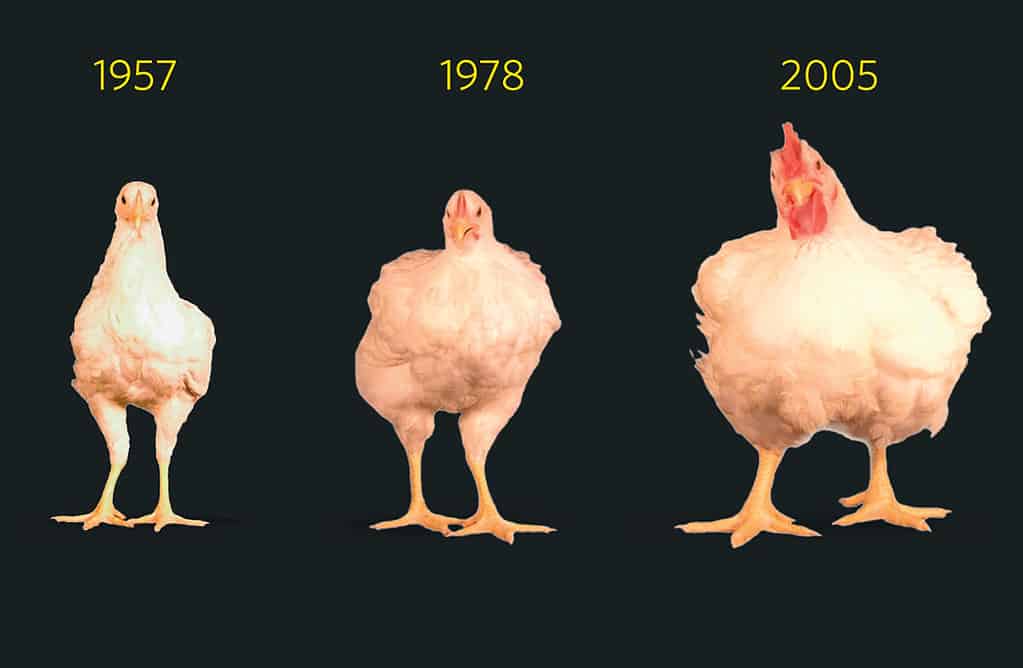
Chicken is by far the most popular protein in the United States, accounting for over 40% of all meat consumed in the nation. The average American now eats three times as much chicken as their grandparents ate. A lot of people obviously love chicken, but most have no idea just how much poultry has changed in the last couple of decades alone.
If you were born in the 50s or 60s and you compare the size of the chicken you used to eat then with the ones on your plate today, you might be in for a shock.
Chickens used to be much smaller and more nimble. But, as the demand for chicken skyrocketed after World War II, chicken farming changed from a small, family-owned business to a large, industrial enterprise.
The result? Chickens have grown tremendously in size.
It’s difficult to fathom just how large today’s farmed chicken has become, but consider this fact: broiler chicken has swelled in size from less than 1 kg in the 1940s (2.2 pounds) to up to about 4 kilograms (8.8 pounds) in the mid-2000s. Furthermore, they grow this large three times faster than half a century ago.
However, it is not hormones or drugs that are responsible for these highly significant changes, as many people believe. Instead, what explains this great ‘swelling’ are genetic selection and market forces. Let’s take a closer look.
The great chicken growth spurt
Until people turned chicken rearing into large-scale industrial production in the 20th century, both the economic and nutritional contribution of this livestock was rather modest for centuries. That’s in contrast to much more useful animals like the horse and ox used for intensive farm work and transportation, or the robust pig and cattle used for food.
The earliest cultural mention of chicken in Europe is found on Corinthian pottery dating from the 7th century BC. However, the first domesticated chicken appeared much earlier, some 7,000 to 8,000 years ago in China, Southeast Asia, and India from a wild progenitor known as the red junglefowl (Gallus gallus).
Remarkably, Charles Darwin argued that the red junglefowl was the ancestor of today’s barnyard descendants all the way back in the 19th century, something that would be confirmed with the first map of the chicken genome completed in 2004.
The chicken genome revealed how thousands of years of artificial selection led to the selection of various useful mutations, including those that regulate glucose metabolism and promote obesity (a good thing in an animal farmed for meat), as well as a particularly key mutation that disables a gene called TSHR that coordinates reproduction with the length of day and the seasons. With this gene disabled, modern chickens can breed — and thus lay eggs — all year long, all the time.
In a very recent essay published in March 2023, Professor Paul B. Siegel of Virginia Tech — who has been studying broiler genetics and breeding for more than 75 years — notes that “although the chicken was domesticated during Neolithic times, the development of genetic programs designed for broiler performance (meat) was a 20th-century event.”
It all started with the scientific community’s finer grasp of Mendelian genetics in the early 20th century, which allowed scientists to better understand how to select certain traits in their breeding programs. But selection went into overdrive in the late 1940s as the demand for poultry surged.
Farmers raced to produce the perfect strains of “layers” (breeds raised to produce huge amounts of eggs) and “broilers” (breeds that are plump and meaty, primarily used for food) — and this trend would be perfectly illustrated by the ‘Chicken of Tomorrow’, a contest (or genius PR marketing gimmick) promoted by A&P, once the largest supermarket chain in the United States.
The Chicken of Tomorrow: here, today
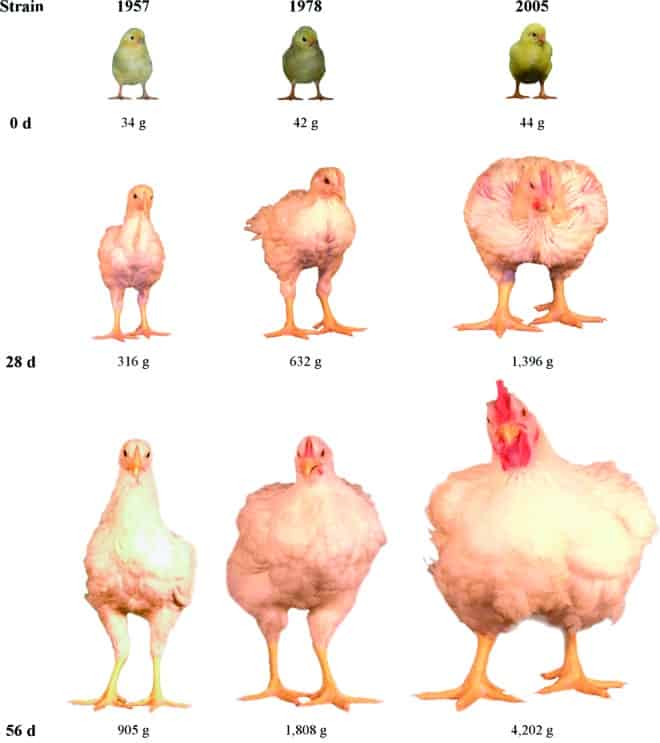
A&P was worried that Americans’ growing appetite for chicken would keep up the costs of production, which were astronomical by today’s industrial farming standards. So some bright minds at A&P devised the Chicken of Tomorrow contest, designed to enhance the brand of the company while also offering a potential means of cutting costs in the future.
The rules of the contest were very simple and would award the top prize to whoever could come up with the fattest chicken grown in the shortest amount of time. Taste was not a criterion for selection.
Thousands of chicken breeders from 25 states flocked in with their entries hoping to win the $10,000 prize (about $100,000 in today’s money), but only two breeds rose to the top. The Arbor Acres White Rocks’ white feathered birds won the ‘purebred’ category, while the Red Cornish Crosses from the Vantress Hatchery in Virginia dominated all other entries in size, width, and weight.
The two strains would eventually get cross-bred, leading to the Arbor Acre breed, a huge type of chicken that would go on to set the standard for all other strains to this day.
Selective breeding continued, with farmers often selecting the plumpest chicks out of the brood for more breeding — and again and again, always with an eye on enhancing productivity.
In 2014, researchers at the University of Alberta led by Martin Zuidhof set out to see just how large chickens have grown since the great swelling began. They compared three types of broiler chicken: a breed that hasn’t been altered since 1957, a second that hadn’t been altered since 1979, and a third modern commercial strain called the Ross 308 broiler.
The scientists fed several individuals from each of the three types of chicken identical diets and kept them in the same kind of environment since they were little chicks.
After 56 days, they put them on the scale. The 1957 breed measured 905 grams, the 1978 breed averaged 1,808 grams, while the modern strain tipped the scales at a staggering 4,202 grams.
That’s a whopping more than a 4x increase in body size in just a few short decades. But that’s not all.
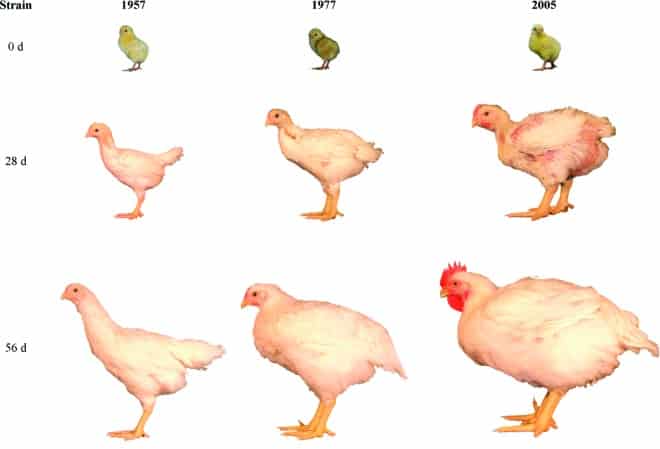
While chickens used to take around 70 days to bring to market, they now need just 47 days, according to the National Chicken Council. However, the average broiler can mature to slaughter age much faster than that, in just 35 days, about half the time it took in 1948.
The feed-to-breast ratio — or how many grams of food can be turned into grams of breast meat — tripled from 1950 to 2005, while breast size itself increased by 80%. So not only are today’s chickens much larger, but they’ve grown plump on less food, which is perhaps the most perplexing thing out of all this.
While browsing official data on chicken measurements performed by researchers and industry professionals, it may look like chickens haven’t quadrupled in size. For instance, at first glance, the historical data listed below suggests that the average broiler put on the market has only doubled in size compared to 1950.
However, the 1950 broiler (1.35 kg/3 lbs.) grew for 70 days before slaughter whereas the average broiler today grows to 3 kg (6.5 lbs) in only 47 days. If they were allowed to grow for the same amount of days, broiler size sits somewhere between triple and quadruple that of the 1950s variety. “We looked at birds of the same age,” Zuidhof told ZME Science, explaining the discrepancy in the observed data.
“[It] depends on age to market weight or weight at a specific age. Also, a broiler is not a broiler is not a broiler. There are all kinds,” Siegel told me.
| Year | Market Age average days | Market Weight pounds, liveweight | Feed to Meat Gain pounds of feed to one pound of broiler, liveweight | Mortality percent |
|---|---|---|---|---|
| 1925 | 112 | 2.5 | 4.7 | 18 |
| 1935 | 98 | 2.86 | 4.4 | 14 |
| 1940 | 85 | 2.89 | 4 | 12 |
| 1945 | 84 | 3.03 | 4 | 10 |
| 1950 | 70 | 3.08 | 3 | 8 |
| 1955 | 70 | 3.07 | 3 | 7 |
| 1960 | 63 | 3.35 | 2.5 | 6 |
| 1965 | 63 | 3.48 | 2.4 | 6 |
| 1970 | 56 | 3.62 | 2.25 | 5 |
| 1975 | 56 | 3.76 | 2.1 | 5 |
| 1980 | 53 | 3.93 | 2.05 | 5 |
| 1985 | 49 | 4.19 | 2 | 5 |
| 1990 | 48 | 4.37 | 2 | 5 |
| 1995 | 47 | 4.67 | 1.95 | 5 |
| 2000 | 47 | 5.03 | 1.95 | 5 |
| 2005 | 48 | 5.37 | 1.95 | 4 |
| 2006 | 48 | 5.47 | 1.96 | 5 |
| 2007 | 48 | 5.51 | 1.95 | 4.5 |
| 2008 | 48 | 5.58 | 1.93 | 4.3 |
| 2009 | 47 | 5.59 | 1.92 | 4.1 |
| 2010 | 47 | 5.7 | 1.92 | 4 |
| 2011 | 47 | 5.8 | 1.92 | 3.9 |
| 2012 | 47 | 5.85 | 1.9 | 3.7 |
| 2013 | 47 | 5.92 | 1.88 | 3.7 |
| 2014 | 47 | 6.01 | 1.89 | 4.3 |
| 2015 | 48 | 6.12 | 1.89 | 4.8 |
| 2016 | 47 | 6.16 | 1.86 | 4.5 |
| 2017 | 47 | 6.20 | 1.83 | 4.5 |
| 2018 | 47 | 6.26 | 1.82 | 5.0 |
| 2019 | 47 | 6.32 | 1.80 | 5.0 |
| 2020 | 47 | 6.41 | 1.79 | 5.0 |
| 2021 | 47 | 6.46 | 1.79 | 5.3 |
| 2022 | 47 | 6.56 | 1.77 | 5.3 |
But this tremendous growth comes at a cost: first and foremost, to the chicken. As a result of growing so large, broilers are often plagued by leg weakness, heart disease, and respiratory issues. The poor birds look rather malformed and cartoonish too, sort of like a mix between Foghorn Leghorn and Johnny Bravo. Not a great look!
Breeders have of course taken note and have adjusted their selection so modern breeds are now more robust, having stronger legs, for instance.
“The primary breeders are selecting much less intensively for larger size, and are more focused on efficiency, livability and reproductive traits,” Zuidhof says.
However, even if more modern broilers haven’t skipped leg day, many of these docile birds are still under tremendous amounts of stress due to the intense farming practices required to produce extremely cheap and abundant chicken meat.
The High-Energy diet
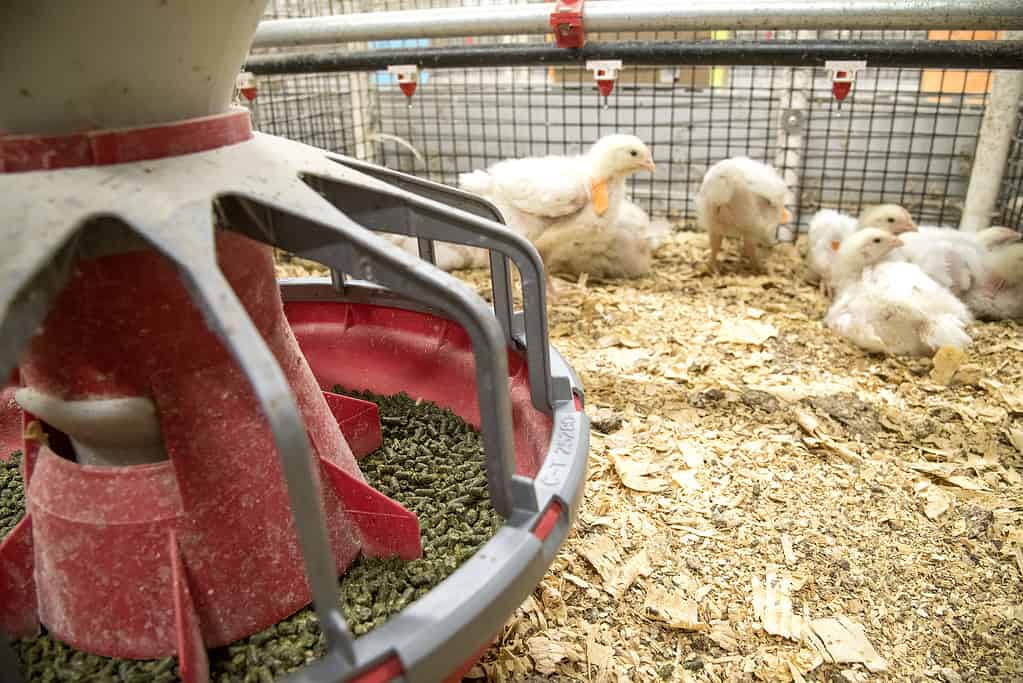
Of note is that chickens have grown very large also thanks to optimized nutrition. The typical broiler is fed grains like corn, which is very calorie dense, soybeans for proteins, vitamins and minerals for enhanced immunity, and enzymes that help the birds digest phosphorus and protein better, while also helping to break down the nitrogen in broiler waste.
Chickens are no longer fed cabbage, table scraps, and just about anything people used to discard around their backyards. This new type of feed is now known to poultry scientists as the ‘high-energy diet’. These aren’t exactly superfoods, but chicken farms will typically use just the right amount of calories and protein to maximize growth while minimizing costs.
And a third major reason for the rapid growth is a much better understanding of the kind of environment that chickens need to maximize their genetic and nutritional potential. This includes things such as providing the right temperature, air quality, ventilation, and lighting, as well as feeder and drinker space.
Note that the comfort of chickens is of little importance, although more and more farmers are taking livability more seriously. What mostly matters is yield.
Still, these factors are rather secondary. Genetics is king in explaining broiler size gains over the last 75 years.
“Husbandry practices and high-energy diets were contributing factors, but they were secondary to the dynamics of selection and crossing of specific male and female lines, i.e., breeding and genetics were the primary contributors,” Siegel wrote in his essay.
No, it’s not hormones

It’s easy to look at the gains made by chicken strains and conclude something fishy is going on. However, it’s not true at all that chickens are injected with steroids, growth hormones, or artificial enhancements of any kind. These additives are illegal in most countries, including the United States.
However, growth-promoting hormones are allowed and often used in cattle ranching, which may explain why people would think the same applies to chickens too. But that doesn’t mean there aren’t any drugs used in the chicken farming industry. Copious amounts of antibiotics are given en masse, mixed with the birds’ feed in order to protect them from the rampant diseases that are inevitable in the cramped cages they live in. Thanks to antibiotics, the mortality of chickens has plummeted from nearly 20% in the 1920s to just 5% in modern times. However, the indiscriminate use of these drugs may also be fueling very dangerous antibiotic resistance.
Instead, all of these massive changes in size can be largely explained by genes and their mutations that have been selected over the ages, especially in the last couple of decades.
The chicken’s reproductive cycle helps a lot in this regard. Your average hen can easily produce 120 chicks over the year, each of which can start breeding after only 25 weeks. In the United States alone, around 9 billion broilers are produced each year. That’s a huge pool of chickens to selectively breed.
It’s then a matter of just picking the heftiest from the brood and breeding that individual more. The extremely short breeding cycle fits this strategy like a glove.
“There is a lot of misinformation about this topic. We did the study to provide scientific data on the reasons for higher growth rates in modern chickens. It is NOT due to steroid hormones (feeding or injection), but rather because of effective programs that selected chickens with higher growth rates, yield, and efficiency,” says Zuidhof.
“There have been unintended consequences along the way (e.g. metabolic and skeletal problems) that have since been corrected by more balanced selection programs that strongly consider bird health and welfare, but this message is overpowered by people and groups who don’t understand the underlying science, or have ethical issues with using animals for food. It is often easier to stick with one’s long-held opinion than to change that opinion based on the facts. We actively preserve several randombred genetic lines to be able to provide objective scientific data on the subject.”
Humans have been using artificial selection for thousands of years not only to domesticate wild beasts, but also to turn wild plants into food crops. Perhaps the most iconic example of selective breeding is the North American sweetcorn, which was bred from the barely edible teosinte plant. Today, corn is 1,000 times larger than it was 9,000 years ago and much easier to peel and grow.
Then there are dogs. From chihuahuas to great Danes, dogs differ more in size than any other mammalian species on the planet. In some situations, the difference in size between the smallest and the largest dogs can exceed 100-fold. Perhaps a similar size jump between different chicken breeds could also be possible, although I’m not sure the world is ready for a 200-pound chicken.
While farmers would like to reach similar gains with other livestock, it simply isn’t biologically possible. For instance, a cow will only birth one calf per year. It would take centuries to come up with similar results in size and mass augmentation as with chickens using artificial selection — and not even then because there are important biomolecular and genetic factors that can put a hard ceiling on growth unless you exchange genetic selection for genetic editing. That’s a whole different ball game.
The artificial selection of chickens is never-ending though. Scientists continue to select chicks with better growth rates, more efficient feed-to-meat conversions, and stronger immunity to disease.
What about the bland taste?
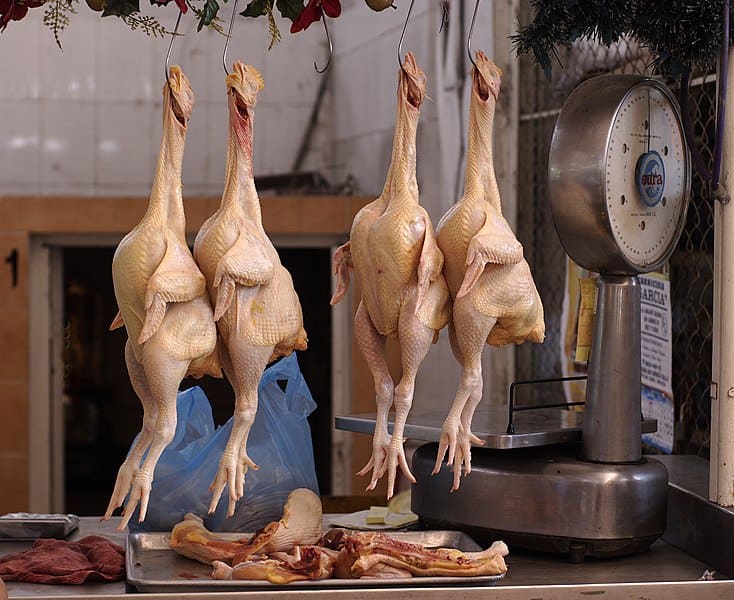
It’s an old dad joke, but whenever we can’t describe a flavor, people often just say it “tastes like chicken”. That’s because chicken can be so generic. But it wasn’t always necessarily like this.
Chicken today is so incredibly bland, it has to be heavily processed in order to make it palatable. This means adding a ton of seasoning or encasing it into a flavor ‘vehicle’, such as nuggets, strips, and patties.
However, there was a time when chicken was distinctly flavorful and quite expensive. Some people swear you can still find this fabled poultry, but it’s not easy. That’s because you won’t be able to find it in normal supermarkets.
What supermarkets sell is essentially the meat of adolescent chickens, which have barely had time to mature. In the early 20th century, broilers were slaughtered around the 4-month mark, compared to a little over a month nowadays.
Mature backyard chickens had longer legs relative to their bodies, smaller breasts, and yellower skin than regular supermarket broilers. But most importantly, these chickens of yore had a much more diverse diet, which can influence the taste of animal flesh through a phenomenon known as biodistribution.
Pork from hogs that are fed a fish meal diet tastes different from pork from hogs that are fed a corn-based diet. Lamb and beef produced on different diets can lead to changes in the concentration of many flavor volatile compounds. Chicken may be no different.
Modern broiler breeds are also much leaner than earlier strains, and the different fat content may also be an important factor affecting the taste profile.
“I’m not an expert on this. You’ve probably heard the expression ‘you are what you eat’. Birds harvested at a younger age have eaten less and probably accumulated less flavor compounds than older birds that have roamed a yard picking up all sorts of various flavor compounds. Modern broilers are also leaner, and fat is delicious (we’ve evolved to enjoy foods that help us pass on our genes). Leaner meat from modern broilers, though better for Homo Sapiens that are not lacking food supply, may be less tasty because there is less fat,” Zuidhof commented.
It’s rather challenging though to explain or track the flavor profile of modern broilers, largely because taste can be such a subjective experience. People who lament the flavor profile of modern chicken may also suffer from nostalgia and tend to embellish how good chicken used to taste in the 1950s or 1960s.
A growing appetite
Ultimately, the main reason why chickens have become so plump over the years is because of us and our insatiable appetite for their tender meat. Chickens are by a wide margin the most numerous type of livestock on the planet, numbering over 34 billion, up from 14 billion in 2020. There are about 135 chickens for every cow and three for every human.
But despite chicken numbers having swelled, their living conditions are still appalling. About 70% of broilers around the world are raised in intensive farming systems, living their short lives in overcrowded, filthy sheds with little to no access to the outdoors, fresh air, or even sunlight.
While chicken remains a popular source of protein worldwide, there are growing concerns about the animal welfare and environmental impacts of the larger, selectively bred chickens that dominate the industry today. As we continue to grapple with the consequences of our food choices, it is important to consider the impact of these choices on both our food supply and the welfare of other animals.
In the end, it is up to us to decide what kind of food system we want to support, and how we can work together to create a better future for ourselves, our animals, and our planet.


